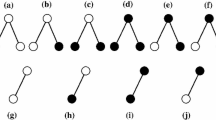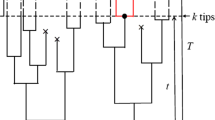Abstract
This article provides a method for calculating the joint probability density for the topology and the node times of a tree which has been produced by an multi-type age-dependent binary branching process and then sampled at a given time. These processes are a generalization, in two ways, of the constant rate birth–death process. There are a finite number of types of particle instead of a single type: each particle behaves in the same way as all others of the same type, but different types can behave differently. Secondly, the lifetime of a particle (before it either dies, changes to another type, or splits into 2) follows an arbitrary distribution, instead of the exponential lifetime in the constant rate case. Two applications concern models for macroevolution: the particles represent species, and the extant species are randomly sampled. In one application, 1-type and 2-type models for macroevolution are compared. The other is aimed at Bayesian phylogenetic analysis where the models considered here can provide a more realistic and more robust prior distribution over trees than is usually used. A third application is in the study of cell proliferation, where various types of cell can divide and differentiate.
Similar content being viewed by others
References
Agapow PM, Purvis A (2002) Power of eight tree shape statistics to detect nonrandom diversification: a comparison by simulation of two models of cladogenesis. Syst Biol 51: 866–872
Aldous D (1996) Probability distributions on cladograms. In: Random discrete structures (Minneapolis, MN, 1993). IMA Vol Math Appl 76:1–18. Springer, New York. http://www.stat.berkeley.edu/users/aldous/Papers/me69.pdf
Aldous DJ (2001) Stochastic models and descriptive statistics for phylogenetic trees, from Yule to today. Stat Sci 16: 23–34
Aldous D, Popovic L (2005) A critical branching process model for biodiversity. Adv Appl Probab 37(4): 1094–1115
Alroy J (2008) Dynamics of origination and extinction in the marine fossil record. Natl Acad Sci USA 105(1): 11536–11542
Arrizon V, Tepichin E, Ortiz-Gutierrez M, Lohmann AW, Alroy J (1996) Constant extinction, constrained diversification, and uncoordinated stasis in north american mammals. Palaeogeogr Palaeoclimatol Palaeoecol 127(1): 285–311
Athreya KB, Ney PE (1972) Branching processes. Springer, Berlin
Bellman R, Harris TE (1952) On age-dependent binary branching processes. Ann Math 55: 280–295
Berger JO (1985) Statistical decision theory and bayesian analysis, 2nd edn. Springer, Berlin
Blum MGB, François O (2007) Which random processes describe the tree of life? A large-scale study of phylogenetic tree imbalance. Syst Biol 55(4): 685–691
Brandley MC, Leach AD, Warren DL, McGuire JA (2006) Are unequal clade priors problematic for Bayesian phylogenetics?. Syst Biol 55(1): 138–146
Coyne JA, Orr HA (2004) Speciation. Sinauer Associates, Sunderland
Drummond AJ, Ho SYW, Phillips MJ, Rambaut A (2006) Relaxed phylogenetics and dating with confidence. PLoS Biol 4(5): e88. doi:10.1371/journal.pbio.0040088
Drummond AJ, Rambaut A (2007) BEAST: Bayesian evolutionary analysis by sampling trees. BMC Evol Biol 7: 214
Felsenstein J (2003) Inferring phylogenies. Sinauer Associates, Sunderland. http://dx.doi.org/10.1016/S0022-0000(02)00003-X
Ford D (2005) Probabilities on cladogram: introduction to the alpha model. http://arxiv.org/abs/math/0511246
Ford D, Matsen E, Stadler T (2009) A method for investigating relative timing information on phylogenetic trees. Syst Biol 58: 167–183
Gernhard T (2008) The conditioned reconstructed process. J Theor Biol 253: 769–778
Gernhard T, Hartmann K, Steel M (2008) Stochastic properties of generalised Yule models, with biodiversity applications. J Math Biol 57: 713–735
Heath TA, Zwickl DJ, Kim J, Hillis DM (2008) Taxon sampling affects inferences of macroevolutionary processes from phylogenetic trees. Syst Biol 57(1): 160–166
Huelsenbeck JP, Ronquist F (2001) MRBAYES: Bayesian inference of phylogenetic trees. Bioinformatics 17(8):754–755. http://dblp.uni-trier.de/db/journals/bioinformatics/bioinformatics17.html
Hyrien O, Chen R, Mayer-Proöschel M, Noble M (2010) Saddlepoint approximations to the moments of multitype age-dependent branching processes, with applications. Biometrics 66(2): 567–577
Hyrien O, Mayer-Proschel M, Noble M, Yakovlev A (2005) A stochastic model to analyze clonal data on multi type cell populations. Biometrics 61: 199–207
Jones G (2010) Tree models for macro-evolution and phylogenetic analysis. Syst Biol (to appear)
Kimmel M, Axelrod D (2002) Branching processes in biology. Springer, Berlin
Kirkpatrick M, Slatkin M (1993) Searching for evolutionary patterns in the shape of a phylogenetic tree. Evolution 47: 1171–1181
Kontoleon N (2006) The Markovian binary tree: a model of the macroevolutionary process. PhD thesis, The University of Adelaide
Lawton JH, May RM (1995) Extinction rates. Oxford University Press, USA
Lepage T, Bryant D, Philippe H, Lartillot N (2007) A general comparison of relaxed molecular clock models. Mol Biol Evol. doi:10.1093/molbev/msm193
Nedelman J, Downs H, Pharr P (1987) Inference for an age-dependent, multitype branching-process model of mast cells. J Math Biol 25: 203–226
Nee S, May RM, Harvey PH (1994) The reconstructed evolutionary process. Philos Trans Biol Sci 344(1309): 305–311
Pickett KM, Randle CP (2005) Strange Bayes indeed: uniform topological priors imply non-uniform clade priors. Mol Phylogenet Evol 34: 203–211
Pickett KM, Randle CP (2006) Are nonuniform clade priors important in Bayesian phylogenetic analysis? A response to Brandley et al. Syst Biol 55(1): 147–151
Pinelis I (2003) Evolutionary models of phylogenetic trees. Proc Biol Sci 270(1522): 1425–1431. doi:10.1098/rspb.2003.2374
R Development Core Team (2008) R: a language and environment for statistical computing. R Foundation for Statistical Computing, Vienna, Austria. http://www.R-project.org. ISBN 3-900051-07-0
Sepkoski JJ Jr (1998) Rates of speciation in the fossil record. Philos Trans R Soc Lond B 353: 315–326
Stadler T (2008) Evolving trees—models for speciation and extinction in phylogenetics. PhD thesis, Technische Universität München, Zentrum Mathematik
Stadler T (2009) On incomplete sampling under birth-death models and connections to the sampling-based coalescent. J Theor Biol 261: 58–66
Steel M, McKenzie A (2001) Properties of phylogenetic trees generated by Yule-type speciation models. Math Biosci 170(1): 91–112
Venditti C, Meade A, Pagel M (2009) Phylogenies reveal new interpretation of speciation and the red queen. Nature 463: 349–352
Yakovlev AY, Yanev NM (1989) Transient processes in cell proliferation kinetics. Springer, Berlin
Yang Z, Rannala B (1996) Probability distribution of molecular evolutionary trees: a new method of phylogenetic inference. J Mol Evol 43: 304–311
Yang Z, Rannala B (1997) Bayesian phylogenetic inference using DNA sequences: a Markov chain Monte Carlo method. Mol Biol Evol 14(7): 717–724
Yang Z, Rannala B (2005) Branch-length prior influences Bayesian posterior probability of phylogeny. Syst Biol 54(3): 455–470
Author information
Authors and Affiliations
Corresponding author
Rights and permissions
About this article
Cite this article
Jones, G. Calculations for multi-type age-dependent binary branching processes. J. Math. Biol. 63, 33–56 (2011). https://doi.org/10.1007/s00285-010-0362-8
Received:
Revised:
Published:
Issue Date:
DOI: https://doi.org/10.1007/s00285-010-0362-8
Keywords
- Tree
- Tree shape
- Branching process
- Bellman–Harris
- Bayesian phylogenetic analysis
- Macroevolution
- Cell proliferation




